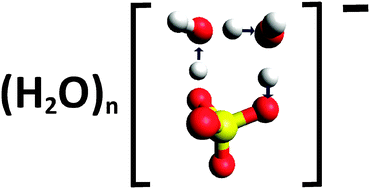Proton mobility and stability of waterclusters containing the bisulfate anion, HSO4−(H2O)n†
Abstract

* Corresponding authors
a
Mass Spectrometry Laboratory and Centre of Theoretical and Computational Chemistry, Department of Chemistry, University of Oslo, POB 1033 Blindern, N-0315 Oslo, Norway
E-mail:
einar.uggerud@kjemi.uio.no
b Department of Chemistry, Atmospheric Science, University of Gothenburg, SE-412 96 Göteborg, Sweden

 Please wait while we load your content...
Something went wrong. Try again?
Please wait while we load your content...
Something went wrong. Try again?
A. S. Zatula, P. U. Andersson, M. J. Ryding and E. Uggerud, Phys. Chem. Chem. Phys., 2011, 13, 13287 DOI: 10.1039/C1CP21070J
To request permission to reproduce material from this article, please go to the Copyright Clearance Center request page.
If you are an author contributing to an RSC publication, you do not need to request permission provided correct acknowledgement is given.
If you are the author of this article, you do not need to request permission to reproduce figures and diagrams provided correct acknowledgement is given. If you want to reproduce the whole article in a third-party publication (excluding your thesis/dissertation for which permission is not required) please go to the Copyright Clearance Center request page.
Read more about how to correctly acknowledge RSC content.
 Fetching data from CrossRef.
Fetching data from CrossRef.
This may take some time to load.
Loading related content
